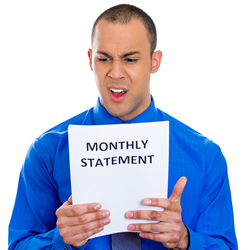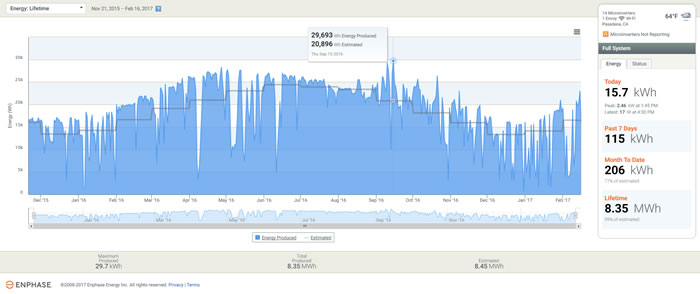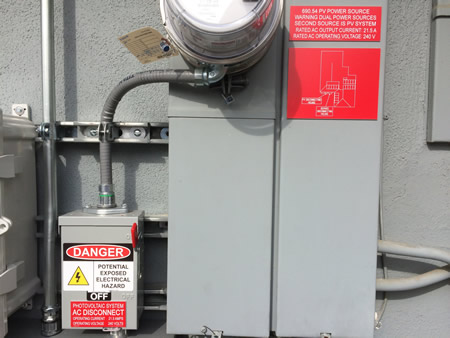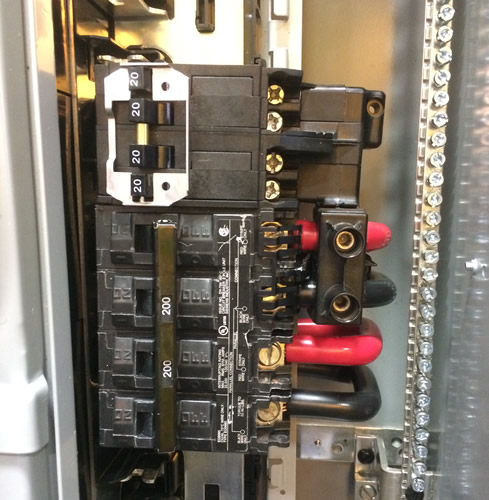Welcome to the
Run on Sun Monthly Newsletter

In this Issue: |
December, 2017
Volume: 8 Issue: 12
Happy New Year's Eve! As we ring out 2017, and look forward to 2018, we thought we would recap the year
by looking at our biggest blog posts of the year. Enjoy, and we will see you next year!
I've got solar; why is my bill so high?
Your system just isn't working!Although this tends to be the number one suspected reason for why the bill is so high, generally it isn't the actual cause. Most systems are installed properly and are in operation. But every now and then we come across a system that simply isn't working at all. That was the case with one man who was convinced that his system had never worked and that the company that installed it was simply out to cheat him. We didn't see signs of that—the system had been installed and the overall workmanship was acceptable on the surface, so it wasn't like someone just slapped the panels on the roof and ran away. But here's the thing—this was an Enphase system so there should have been monitoring in place to answer the question of how well the system was working. Except that the installer had never bothered to complete the setup of the monitoring system! When we came out we were able to access the Envoy directly, and while it could see the microinverters, it was clear that they had never produced any power—in over a year! So how can a solar system owner prevent this? Simple—when your system goes live, make sure that the installer walks you through the operation of the system so that you can see with your own two eyes that the system is actually producing power. (This could be a readout on the inverter/monitoring system, or a spinning performance meter, or an indication that utility meter is going backwards.) Better yet, ask them up-front how will you be able to know that your system is working, and then when it goes live, make them prove it to you! Your system is working, but…This second case is actually far more likely: the system is performing, but it is not meeting your savings expectations. In our experience there are two main reasons for this: hype and over use. Beware the hypeOne reason for this disconnect is that a dishonest sales person over-hyped the savings to be had from the system installed. For example, we have seen "savings" projections based just on the size of the system, without regard for how shaded the system was, or its orientation - to say nothing of the actual rate structure that is being used by the utility. Shaded systems produce less energy. Systems aligned away from South will produce less energy. A utility customer on a time-of-use rate structure may well save less than one on a tiered rate structure (depending on how those rates are designed). The point is to beware of overly simplistic savings projections. A proper analysis will factor in all of these issues to provide the best possible estimate of savings. Solar is not a silver bulletEven the best savings projection is predicated on future energy usage being consistent with the historical data that the solar company was given (unless increases are specifically discussed and included). While many people with solar power systems become vigilant about reducing their overall energy consumption, others go in exactly the opposite direction. Indeed, it is not uncommon to hear people say that part of why they want to "go solar" is so they can afford to run their air conditioning "more" during the summer. Solar power systems are finite resources—they can only produce so much energy consistent with the size of the system, and most utilities limit system size to the historical energy usage average at the site. If you install solar, but then triple how much energy you use during the year, you shouldn't be surprised if you are not saving any money! What we have here is a failure to communicate!Which leads us to the most likely culprit—there has been a failure to communicate between installer and consumer. At the root of this is Net Metering and the complexities of most energy bills. (A big part of the blame here goes to the utilities who seem determined to make their bills as complicated as possible!) Let's provide an overview of this issue and then illustrate with a specific example. How Net Metering WorksSolar system owners - at least here in SoCal - operate under utility rules known as Net Energy Metering, or just Net Metering for short. Here is how this works: on the day when your solar power system is given "Permission to Operate" (or PTO) by the utility, your billing will shift to Net Metering (often the utility will change your meter to allow for that switch). Every day, as your system operates, you will either be exporting (selling) energy back onto the grid, or importing (purchasing) energy from the grid. Think of it this way: you get up at 6 a.m. and it's dark outside. You turn on some lights, the radio, coffee maker, etc. Your solar system isn't producing anything (it's dark outside, remember?) so you are purchasing energy from the grid. You go off to work as the sun comes up, and your system turns on. All day long, your solar system is producing energy, but there is no one there to use it—the A/C is off, the TV is off, the house is dark—so all of that excess energy is sold back to the utility. Your fancy new meter keeps track of all of that energy coming and going. Every billing cycle the utility will look at those readings—how much energy did you sell compared to how much did you purchase—and "net" out the difference. If you were a net seller of energy, you will have a credit. If you were a net purchaser of energy you will have a balance due. But here is where some people get confused—your bill won't ask you to pay for the energy you used that month. Typically you will only be charged for whatever "customer charge" there may be along with taxes and other fees. The bill for your energy usage (or credit, if you are so lucky) is carried forward to the next billing cycle, and the next, and the next, until you get to the anniversary of your PTO date. Now your usage will be "trued up" and you will either get a bill to pay (assuming that for the year you were a net energy purchaser) or a check (assuming you were a net energy seller, but don't get too excited because that payment is really tiny). Here's the thing, depending on how much of a net energy purchaser you were, that bill could be pretty significant, in some cases well over a thousand dollars or more! Of course, you would have been receiving bills every cycle that showed what you were accumulating (either a balance due or a credit) but since there is no related payment required, it is easy for some to overlook those bills, and if this process has never been explained—or even if it was but the consumer simply didn't "get it" at the time—this can lead to a nasty surprise. Bottom line - solar companies need to do a better job here in explaining how this works. (Hence this post!) A real-life exampleConsider a hypothetical solar system owner, let's call him Bob. Now Bob is a smart guy, but this is the first solar power system he has ever owned. His installer explained everything to him when the system went live, but Bob was distracted by the excitement of a potentially zero bill. His system has Enphase microinverters so he has been receiving energy production emails from Enphase every month, and that looked cool, but he never attempted to reconcile his Enphase report with his utility bill (Bob's not so big on balancing his checkbook, either). But to be fair to Bob, the Enphase report that he receives is for each calendar month, but his billing is every two months, and they aren't calendar months; rather, they run from meter read date to meter read date (e.g., 7/28/2016 to 9/26/2016). The good news is that Enphase has a reporting feature that allows you to enter any two dates since the system went live and receive day-by-day energy production, with the total at the end. Let's see what we can learn when we put Bob's billing data next to his production data from the Enphase reporting feature:
The first two columns show the start and end dates for each meter reading/billing cycle. The bought column is the amount of energy that Bob purchased from his utility. (Whoa, what happened during the latest billing cycle???) The sold column is the amount of energy that Bob sold back to his utility during that period, as reported by the utility. The next column is the amount of energy that Bob's system produced during the dates in the billing cycle, according to the Enphase website. But wait, how can this be? In that first period, the utility says that Bob only sold 774 kWh of energy, but Enphase says his system produced nearly twice as much, 1,338 kWh! How do we make sense of this disparity? The answer is simple: local consumption. It is important to remember that the utility has no idea how much energy Bob's system is producing, all they see is how much energy Bob is selling back to them. So both Enphase and the utility are correct, they are just measuring different things. Enphase measures total energy produced. The utility measures energy sold to them—the difference is energy used to power Bob's house that didn't come from the utility; rather, it came from the solar system! In that first billing cycle, Bob's system produced 1,338 kWh and of that, 774 kWh were sold back to the utility, meaning 564 kWh of that production were used to power his house. And that means that Bob's total consumption for the month is the amount that he bought from his utility, 1,402 kWh, plus the solar production that was consumed locally, 564 kWh, for a total consumption of 1,966 kWh. Applying that reasoning to the rest of the data shows that Bob's overall consumption has increased in every billing cycle except one, with a whopper over the holidays! (Maybe too many holiday lights?) The production data shows that Bob's system has been performing appropriately - increasing over the summer months, decreasing over the winter months. Here's a graph that puts that all into perspective:
The blue represents the actual energy produced each day. The gray line is the predicted system production (in this case modeled using the CSI calculator). Over the lifetime of the system, the maximum amount of energy produced in a day was 29.7 kWh (42% above what was predicted for that day) and on the day when this graph was created, the system produced 15.7 kWh. Generally, the performance peaks well above what is expected (particularly in the late June through early November period). But once we get into mid-November things deteriorate—not because of a fault in the system, but because of abnormally wet weather here in SoCal (as we head into a 1"/hour rain storm today!). For much of the past two months, actual production has fallen well below what was predicted, with just 77% of predicted being realized so far this month. And yet, despite all of that, overall the system has still produced 99% of its estimated lifetime production. This points out a couple of key things to me: First, you just gotta love the data that is available through the Enphase monitoring system. It allows system owners and installers alike to have near-real time access to system performance, as well as to review long-term data to discern trends and uncover patterns. Priceless! Second, we as solar professionals need to do a much better job of informing our clients so that they know what to expect. (I'm leaving out the hype-sters who couldn't care less what the consumer knows as long as they make a sale.) We live with this stuff every day but for most of our clients, this is all brand new, and confusing. We need to take the time to explain how this works so that they can understand the actual value of their investment. |
“We as solar professionals need to do a much better job of informing our clients so that they know what to expect…”
Get your copy of
Commercial Solar:
Step-by-Step
from
Run on Sun
Founder & CEO
Jim Jenal

Now available on Amazon.com
in both
Print & Kindle versions.
Bonus - Buy the Print version…
Get the
Kindle version for Free!
Commercial Solar:
Step-by-Step
from Run on Sun
Founder & CEO
Jim Jenal

Now available on Amazon.com
in both Print & Kindle versions.
Get the Kindle version for Free!
Help Us Spread the News!


We use Angie's List to assess whether we're doing a good job keeping valued clients happy. Please visit AngiesList.com in order to grade our quality of work and client service.
Solar Boom Devolves to Power "Glut"The LA Times today featured an article this year titled, "Energy goes to waste as state power glut grows". The article describes how as solar power has grown dramatically in the Golden State, it has lead to a problem that has caused the state to actually pay neighboring Arizona to take our surplus energy! Meanwhile the IOUs are badgering the CPUC to allow them to spend billions on additional natural-gas-fired power plants! This is crazy town, and points to the need to radically redesign the incentives provided to utilities in the state. Here's our take... The perverse incentive here is that the IOUs - SCE, PG&E, and SDG&E - earn their money by building stuff, whether that stuff is used or not. So it would seem that the trick here is to get them to build The Right Stuff, which certainly isn't another natural gas peaker plant. Instead, the clear winner here should be storage, particularly storage at utility scale. Bring enough intelligent storage into the mix and goodbye "Duck Curve" and hello a fossil-fuel-free future. The CPUC should be providing the same rate-making incentive to build vast amounts of storage, even if at a premium price, rather than non-renewable generation capacity. No renewable facility should ever have its output curtailed (as has happened 31% of the time in the first few months of this year), and no renewable energy should ever be exported to a neighboring state, except when such an export serves the economic interest of California ratepayers. California is going to get to 100% renewables, we have to, as does the world. We can and should show the way, but we will need to change the way utilities approach the problem if we are to get there anytime soon. |
The Biggest News at SPI 2017 - B3 BypassWe just got back from Solar Power International 2017 and it featured all the usual players with lots of cool stuff on the (gigantic) floor of the Convention Center at Mandalay Bay. But the biggest deal of the show, from our massively solar geek perspective, came from a tiny booth that no doubt many folks missed altogether. But for many of the potential clients that we see, this was a really big deal! Here's our take... The Sad State of PlayHere in SoCal, we find a great many center-fed service panels - that is, a service panel where the main breaker is located in the middle of the bus. Now in a truly rational world, that wouldn't matter, but around here, the prevailing view is that you cannot use the "120% Rule" on a center-fed panel. (I know this is totally in the weeds, but the 120% Rule says that the sum of all breakers supplying a service panel cannot exceed 120% of the bus rating, and that the solar breaker has to be at the opposite end of the bus from the main breaker.) So, on a 200 A bus, with a 200 A main, the PV breaker is limited to 40 A. All fine and good, but it is that "opposite end of the bus" that causes some AHJs misery - like LA County - who insists that with a center-fed panel, there is no "opposite end of the bus"! (Ignore for the moment that if I have a center fed panel with 10 slots above and below the main, I'm out of luck. But I could have a main panel with a total of 10 slots below my 200 A main, and no one would have a problem with my putting my PV breaker in the bottom slot!) So, we are presently stuck with an ignorant interpretation of the Code and it has meant that some folks needlessly were forced to upgrade a perfectly good center-fed service panel just to go solar. BUT - you have an unprotected connection all the way from the pole to that disconnect - which creates a serious hazard, especially in a residential environment. You can see the interconnection on the right - and the scary danger sticker that we added to provide a suitable warning. (Interestingly, while we have to add all manner of stupid signage - like that directory plaque that provides no useful information whatsoever - there is no requirement for a warning about the hazard presented by that interconnection.) To be extra cautious, we also install a lock on the disconnect door to discourage the curious. Oh, and it costs just under $500 to have SCE install the ring (and their service tech has to suit up to reduce the risk that he gets lit up like a Christmas tree while doing the install). Geez, all this because of a bad code interpretation! To the Rescue - B3 Bypass!Fortunately, there is now an alternative to this madness! A California-based outfit that goes by the not-so-catchy name of QFE002, has come up with a revolutionary product - that is now UL listed! (They have been coming to SPI for years, but they just got UL!)
So what is this game changer? It is the B3 Bypass breaker and it taps directly onto the main conductors going into the main breaker. Because the PV does not go through the bus at all, the 120% rule does not apply. This means that the amount of current that could be backfed by the PV array is only limited by the main conductors feeding that breaker. In the picture on the left, the 200 A main breaker is on the bottom and the B3 Bypass breaker is above. The B3 Bypass clamps down onto two of the four conductors feeding the main. (They have a nifty tool that strips the insulation off without otherwise modifying the conductors, or unscrewing them from the main breaker. Per UL, this does not constitute a modification of the panel, so its UL listing is unaffected - meaning that there is no need for a field certification.) The B3 Bypass comes in various configurations - the dual, twin-pole 20's shown here can actually be as high as twin 60's - meaning that you could install 120 A of solar - triple what could be normally connected to a 200 A service, and twice the 60 A rating of the GMA ring! It is even 50% more than you could install on a 400 A service! Yeah, this could be big! They are taking order requests on their website, although we don't yet have pricing or timing for potential deliveries. (My guess is that they are just now trying to move into production mode, now that UL is behind them.) We passed along their info to both BayWa and CED Greentech - hopefully they will get a distribution deal going so that they can make this available far and wide! We are definitely fans! |





